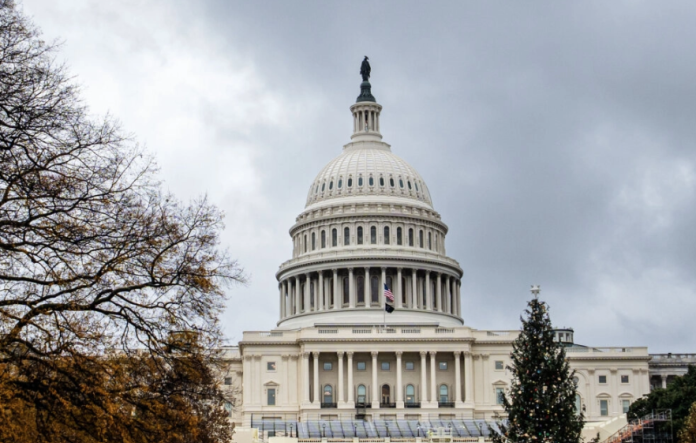Over 120 House Democrats are calling on President Joe Biden to conclude the process for adding the Equal Rights Amendment (ERA) to the U.S. Constitution.
The push, spearheaded by outgoing Rep. Cori Bush (D-Mo.) and Rep. Ayanna Pressley (D-Mass.), wants the lame duck president to urge the national archivist to treat the ERA—an amendment from 1923 that would extend specific constitutional protections on the basis of sex—as having been ratified, despite questions about whether such a move is legal.
They framed the effort as a response to President-elect Donald Trump’s second term, accusing him of having been “openly hostile to reproductive freedom, access to health care, and LGBTQIA+ rights.”
Such a move would have vast implications for U.S. legal life—but any effort by Biden to do what’s being requested would almost certainly be met with substantial challenges by both conservative groups and the incoming Trump administration, who would seek to advocate for clear definitions on sex and gender preference issues.
For supporters, the ERA is an overdue codification of sexual equality.
“By directing the Archivist to publish the ERA, you will leave an indelible mark on the history of this nation, demonstrating once again that your legacy is one of expanding rights, protecting freedoms, and securing a more inclusive future for all Americans,” Bush and Pressley wrote.
“We urge you to take this final, transformative step toward ensuring the full promise of equality for every person in the United States.”
For critics, meanwhile, the ERA has the potential to cause wide-reaching and unforeseen changes to U.S. law depending on how the courts interpret the brief text, with common critiques referencing the court’s expansive interpretations of the 14th Amendment that have drastically reshaped American law.
Other Republicans have expressed concerns that the ERA could lead to forced inclusion for transgender-identifying athletes in women’s sports, or could have other unforeseen impacts due to the proliferation of transgender ideas in American life.
History of the ERA
The letter is the latest development in a debate that’s continued for over 100 years now.
First proposed three years after the 1920 ratification of the 19th Amendment, which gave women the right to vote, the ERA’s core clause reads, “Equality of rights under the law shall not be denied or abridged by the United States or by any state on account of sex.”
Additional clauses give the federal government the right to enforce that clause, which would go into effect two years after ratification.
In 1923, it didn’t get very far, languishing in committee and seemingly fated to join the vast historical wastebasket of failed constitutional amendments.
However, in 1972, both chambers of Congress revived and passed the ERA, initially giving a seven year deadline for ratification. By the time the 1979 deadline came around, 35 states had elected to ratify it, still three short of the 38 needed to add the ERA to the Constitution.
Congress extended the deadline to 1982, but this also came and passed without any additional states ratifying it.
In the intervening years, three state Legislatures—Nevada, Illinois, and Virginia—voted to ratify it between 2017 and 2020.
Legal Uncertainty
The core legal question hinges on whether the 1982 deadline is applicable at all. Bush and the Democrats joining her letter contend that it isn’t.
In the Constitution, the amendment process is an intentionally grueling one: a proposed amendment must win the support of either two-thirds of both chambers of Congress, or two-thirds of the states—34 states—must call for a constitutional convention. Then, three-fourths of the states—38 currently—must approve it for it to be added to the Constitution.
With its approval by 38 states, Bush wrote, “The ERA has fulfilled all of the requirements for adoption outlined by the Constitution.”
In response, Bush and her colleagues hope that Biden will ask the National Archives to publish the ERA as the 28th Amendment to the Constitution. The step is considered an administrative one, and marks the final part of the process
However, the National Archives have in the past declined to do so.
Following Virginia’s ratification of the ERA in 2020—becoming the 38th state to back the amendment—the Trump administration released a memo opining that, because the 1982 deadline had passed, Virginia’s ratification of the document was irrelevant.
Additionally, the memo noted that several states had by that point attempted to rescind their ratification of the document: Nebraska, Tennessee, Idaho, Kentucky, and South Dakota, each of which sought to rescind the ratification prior to the original 1979 deadline.
Then-Archivist David Ferriero followed this memo, and the ERA was not published as part of the Constitution.
Since then, North Dakota has also sought to withdraw its ratification of the document, stating that it was only valid through the original 1979 deadline.
Both of these questions—including whether the deadline was constitutionally valid and whether states can rescind their ratification of an amendment prior to its adoption—would almost certainly be litigated extensively should Biden request that it be added to the Constitution.
If Biden complied with the request, and Archivist Colleen Joy Shogan published the ERA as the 28th Amendment, it would, at least pending litigation, have met the final, administrative step to become part of the Constitution.
Ultimately, it would likely fall to the Supreme Court to litigate the questions underlying the case, including the core question of whether the ERA was a genuine part of the Constitution or not.





















